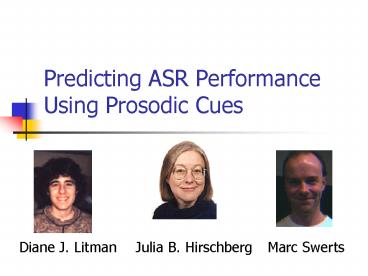Predicting ASR Performance Using Prosodic Cues - PowerPoint PPT Presentation
1 / 17
Title:
Predicting ASR Performance Using Prosodic Cues
Description:
Speaker-relative differences of prosodic values are important (versus ... Adding prosodic information to ASR- available information improves prediciton of ... – PowerPoint PPT presentation
Number of Views:80
Avg rating:3.0/5.0
Title: Predicting ASR Performance Using Prosodic Cues
1
Predicting ASR Performance Using Prosodic Cues
Diane J. Litman
Julia B. Hirschberg
Marc Swerts
2
Problem
- ASR is not perfect but prone to error
- Users
- Have to try to correct system misunderstandings
- Are frustrated by unnecessary confirmations and
rejections - Recognize errors
- How likely is the recognition to be correct?
- Handle errors
- Verifiying users input
- Reprompting for new input
- Changing interaction strategy
- Switching to human attendant
3
ASR performance depends on
- Speaker
- gender
- age
- Native versus non-native
- Speaking style
- Hyperarticulated speech
- Occurs when people try to correct the system
- Decreases performance
- Deviation of new speech from training data
Prosodic cues
4
Tasks
- Compare correctly and incorrectly recognized
speaker turns regarding to prosodic features - How useful are prosodic features to predict
errors in recognition - On their own
- Combined with other information
5
Design
- TOOT corpus speech dialog system for train
information via telephone - Subjects 39 students
- (20/19 native/non-native)
- (16/23 female/male)
- 1994 user turns, 152 dialogues
- Concept accuracy (CA) manually labeled
- 1 if ASR correctly recognized all task related
information in the turn (time, departure, arrival
cities ), otherwise age of correct recognitions - 1410 of 1975 CA 1 (mean 71 )
- Word error rate (WER)
- Manual transcription compared to recognized
string - 961 of 1975 WER 0 (mean 49, mean per turn 47 )
6
Distinguishing Correct from Incorrect Recognitions
- Prosodic features
- F0 mean, max
- Energy (rms) mean, max
- Total duration
- Prior pause
- Speaking rate (syllables per second)
- silence
- Scoring results for each speaker separately and
combing results with paired t-test
7
Results
- Misrecognized turns
- Higher F0 max, higher rms energy
- Longer durations
- Longer preceding pauses
- WER slightly higher in mean F0 and rms max,
lower age of silence - CA tempo lower (?)
- Results derived from raw values for all prosodic
features are similar to results derived from
normalized values (normalized to first or
preceding turn, or converted to z scores) - Speaker-relative differences of prosodic values
are important (versus differences from some
speaker-independent range) - Cf. Table 1, 2 in paper
- Features found are associated with
hyperarticulated speech, but excluding
hyperarticulated turns led to same results
8
Predicting Misrecognitions Using Machine Learning
- Machine learning program RIPPER (Cohen, 1996)
- Input
- classes to be learned (i. e. correct/incorrect
recognition) - Set of feature names and possible values
- Prosodic features
- ASR grammar
- ASR confidence
- ASR string
- Experiment conditions (subject, gender, native
speaker, task number, dialogue strategy.) - Training data
- Output classification model for predicting the
class
9
Results for WER-misrecogn.
- Comparing the performance of classification
models derived from different feature sets - ASR confidence score (22.23 ) worse than ASR
confidence plus prosodic (10.99 ) and worse than
prosodic alone (12.76 ) - ASR confidence plus ASR grammar (17.77 ) worse
than prosodic - ASR string is best single value, available to ASR
systems but not used so far! - Unnormalized prosodic features are better than
normalized (-gt ranges of optimal recognition)
10
Classification rules
- Duration, confidence score, string, tempo,
silence, F0 are used - Not the same features as these shown to be
significant in statistical analyses - No features from experimental conditions were used
11
Results for CA-definition
- features which predicted WER-defined
misrecognition were less succesful in predicting
CA-defined misrecognition - Predictive power of prosodic over ASR features
decreases ! ASR confidence scores should predict
WER rather than CA! - Prosodic features still improve predictive power
of ASR confidence scores (13.52 vs 11.34 - but
not significant at 95 confidence level) - For CA-defined adding prosodic features results
only in minor improvements
12
Summary
- Adding prosodic information to ASR- available
information improves prediciton of misrecognition
based on WER - CA-based improvements are less
- Future research will focuss on the reasons of
this differences - Why is prosody so useful for indicate
misrecognition? - Direct or indirect correlation?
- Longer utterances may provide more chance for
error than shorter ones
13
W99 corpus
- Spoken dialog system used for conference
registration - 3000 utterances obtained by experimental testing
as well as by non-experimental data collection - W99 uses newer and more robust technology than
TOOT - Only WER-based misrecognitions computable
14
Results for W99
15
Results for W99
- normalizing values by preceding turn, only
duration, F0 maximum and tempo remain significant
- absolute deviation from some particular range is
associated with recognition failures rather than
relative differences in prosodic values
16
W99 vs. TOOT
- Both
- Prosody plus ASR confidence is better than
confidence alone - Multiple prosodic features outperform singles
- Differences
- Best single value W99 silence, TOOT duration
- TOOT best performing set included prosody, W99
not - TOOT only prosody is better than ASR confidence,
W99 worse (but not significant) - Conclusion the better the ASR model the smaller
the advantage of using prosodic feature
17
Goat phenomenon
- Some speakers are worse recognized than others
- Goats
- higher overall F0 maxima
- tempo lower
- Normalizing over first turn F0 not significant
anymore -gt goats have higher ranges - Goats speech does not exhibit exactly the
features that characterizes misrecognized turns!































